202409-Notes for reading
20240923
1. Discovery of a millisecond pulsar associated with Terzan 6
https://ui.adsabs.harvard.edu/abs/2024arXiv240910801G/abstract
Observations show that globular clusters might be among the best places to find millisecond pulsars. However, the globular cluster Terzan 6 seems to be an exception without any pulsar discovered, although its high stellar encounter rate suggests that it harbors dozens of them.
We report the discovery of the first radio pulsar, PSR J1751-3116A, likely associated with Terzan 6 in a search of C-band (4-8 GHz) data from the Green Bank Telescope with a spin period of 5.33 ms and dispersion measure, DM ≃ 383 pc cm\(^{-3}\). This is the highest radio frequency observation that has led to the discovery of a pulsar in a globular cluster to date.
While L-band (1-2 GHz) observations of this cluster are unlikely to yield significant returns due to propagation effects, we predict that further pulsar discoveries in Terzan 6 will be made by existing radio telescopes at higher frequencies.
Higher frequency can be an important factor to dected new GC pulsar, such as new discoveries recently in GLIMPSE-C01 (450 − 520 cm\(^{-3}\)), Terzan 6 (DM~383 cm\(^{-3}\)).
2. Increasing the detectability of long-period and nulling pulsars in next-generation pulsar surveys
https://ui.adsabs.harvard.edu/abs/2024arXiv240603806G/abstract
Recent discoveries of multiple long-period pulsars (periods ∼10 s or larger) are starting to challenge the conventional notion that coherent radio emission cannot be produced by objects that are below the many theorised death lines. Many of the past pulsar surveys and software have been prone to selection effects that restricted their sensitivities towards long-period and sporadically emitting objects.
We simulate both long-period and nulling pulsar signals, using the Southern-sky MWA Rapid Two-meter (SMART) survey data as reference and explore the detection efficacy of popular search methods such as the fast Fourier transform (FFT), fast-folding algorithm (FFA) and single pulse search (SPS). For FFT-based search and SPS, we make use of the PRESTO implementation, and for FFA we use RIPTIDE. We find RIPTIDE’s FFA to be more sensitive; however, it is also the slowest algorithm. PRESTO’s FFT, although faster than others, also shows some unexpected inaccuracies in detection properties. SPS is highly sensitive to long-period and nulling signals, but only for pulses with high intrinsic signalto-noise ratios. We use these findings to inform current and future pulsar surveys that aim to uncover a large population of long-period or nulling objects and comment on how to make optimal use of these methods in unison.
20240902
1. Unveiling Low-Frequency Eclipses in Spider MSPs using wideband GMRT Observations
https://arxiv.org/pdf/2408.16460
1--For the first time, we detected an eclipse at a non-standard orbital phase (∼ 0.5) for PSR J1810+1744, with a duration longer than the eclipse observed at superior conjunction。
2--The analysis, supported by the Kolmogorov–Smirnov statistic, reveals that eclipsing black widow binaries generally exhibit a higher mass function compared to non-eclipsing black widow binaries, as reported by previous studies for a limited sample of black widow MSPs.
2. Investigating cannibalistic millisecond pulsar binaries using MESA: new constraints from pulsar spin and mass evolution
https://arxiv.org/pdf/2408.16048
1--This work supports earlier claims that RBs evolve into BWs. We also show that the fastest spinning pulsars may collapse
before reaching sub-millisecond spin periods.
3. A 2.9-hour periodic radio transient with an optical counterpart
https://arxiv.org/pdf/2408.15757
1--This source was discoveried in archival low-frequency data from the Murchison Widefield Array. This source display complex microstructure and high liner polarization, suggesting a pulsar-like emission mechanism. A tentative evdence of a ~ 6 year modulation was measured over more than a decade with the analyzed of pulsar timing. It could be a M-dwrf / white dwarf binary scenario for this system.
4. A multi-band study of pulsar glitches with Fermi-LAT and Parkes
https://arxiv.org/pdf/2408.15022
A comprehensive analysis of glitches in four gamma-ray pulsars by combining the timing observation data of Fermi Large Area Telescope (Fermi-LAT) and Parkes 64 m radio telescope
20240831
1. A coherent acceleration search of the Parkes multibeam pulsar survey - techniques and the discovery and timing of 16 pulsars
R. P. Eatough,https://ui.adsabs.harvard.edu/abs/2013MNRAS.431..292E/abstract
This papar conducted a acceleration searches in the time domain that are fully coherent and without the loss of the sensitivity encoutered in stacking algorithm with the method of "timing domain resample", then the time series with different trial accelerations were searched for pulsar in the spectrum after FFT.
2. The High Time Resolution Universe Pulsar Survey – XII. Galactic plane acceleration search and the discovery of 60 pulsars
C. Ng, https://ui.adsabs.harvard.edu/abs/2015MNRAS.450.2922N/abstract
3.The High Time Resolution Universe Pulsar Survey - XIII. PSR J1757-1854, the most accelerated binary pulsar
https://ui.adsabs.harvard.edu/abs/2018MNRAS.475L..57C/abstract
This pulsar was discovered with the pipeline of C.Ng
20240828
1. MeerKAT Pulsar Timing Array parallaxes and proper motions
https://arxiv.org/pdf/2401.06963
This work analyzed several pulsars parameters distribution.
2. PhD, 2018, Cameron, Andrew David_2018_Innovative Pulsar Searching Techniques
Fantasic pulsars and how to find them!
This theis presents the detailed study of the Fast Folding Algorithm.
The author of this thesis present the article "The High Time Resolution Universe Pulsar Survey - XIII. PSR J1757-1854, the most accelerated binary pulsar"
The so-called P-Pdot diagram of pulsars can be ueed to provide insights into the evolutionary histories.
--Science applications of pulsars.
1-Direct detection of gravitational waves.
2-The behaviour of matter at ultra-high densities.
3-Plasma pyysics in extremely enviroments.
4-The structure of the Galaxy and ISM.
5-Processes of stellar and binary evolution.
6-Determinging the properties of the true pulsar population.
--The $match~filtering $ of \(accelsearch\) in PRESTO and the \(resampling\) technique of SIGPROC.
For a search of a single time series de-dispersed at a single trial DM, the match filtering technue stands out as comoputationally superior to the technque of time domain resampling, as a number of different matched filters corresponding to different trial accelerrations can be appiled to the same Fourier spectrum for a single FFT, while the time domain resampling technique requires one FFT per acceleration trial.
--additional techniques of searching for accelerated pulsar in a compact orbits.
--1-Stack / slide searches developed by Faulkner et al. 2004,
One key disadvantage of this technique is that it is incoherent by virtue of its segmented nature, and hence does incur a subsequent loss in sensitivity compared to other, coherent acceleration techniques.
--2-Phase modulation searches proposed in Ransom (2001), Jouteux et al. (2002) and Ransom et al. (2003),
one disadvantage of this technique is that extracting additional information about the orbit of the pulsar, including its orbital phase φ, eccentricity e and semi-major axis x is often non-trivial, and typically requires additional searching and/or processing of the sidebands.
--A schematic diagram of the Keplerian orbital parameters and other associated quantities.
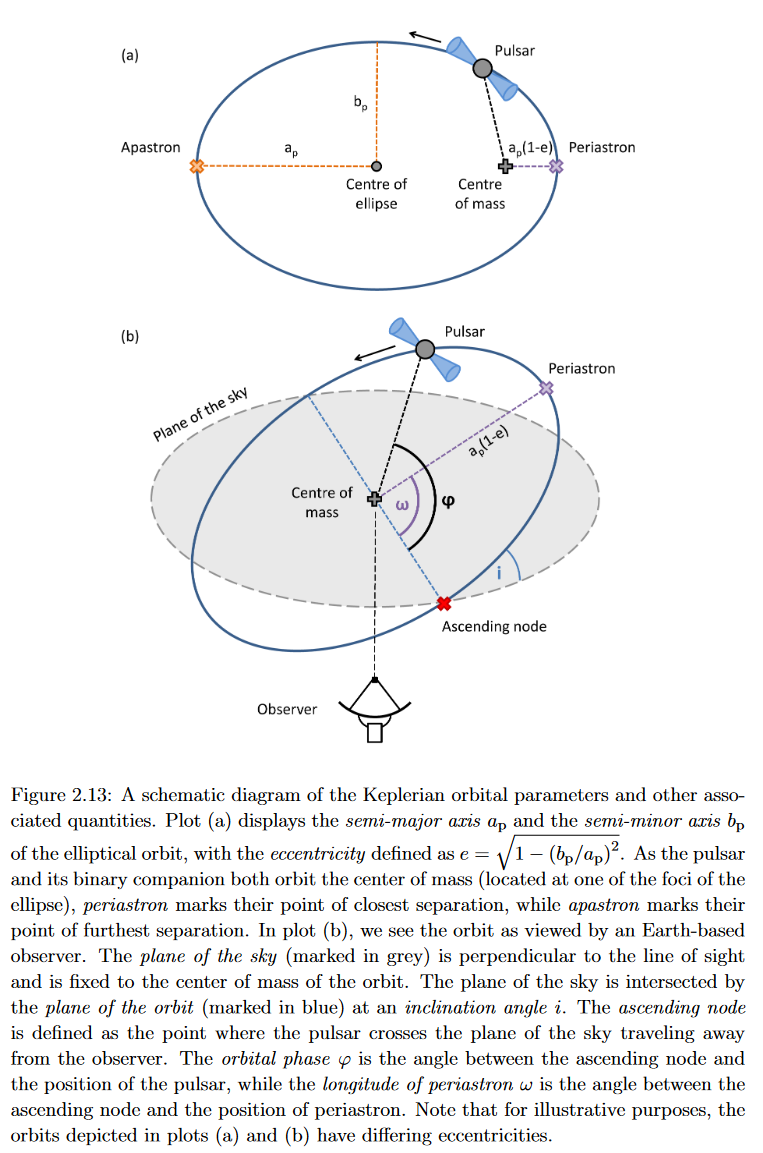
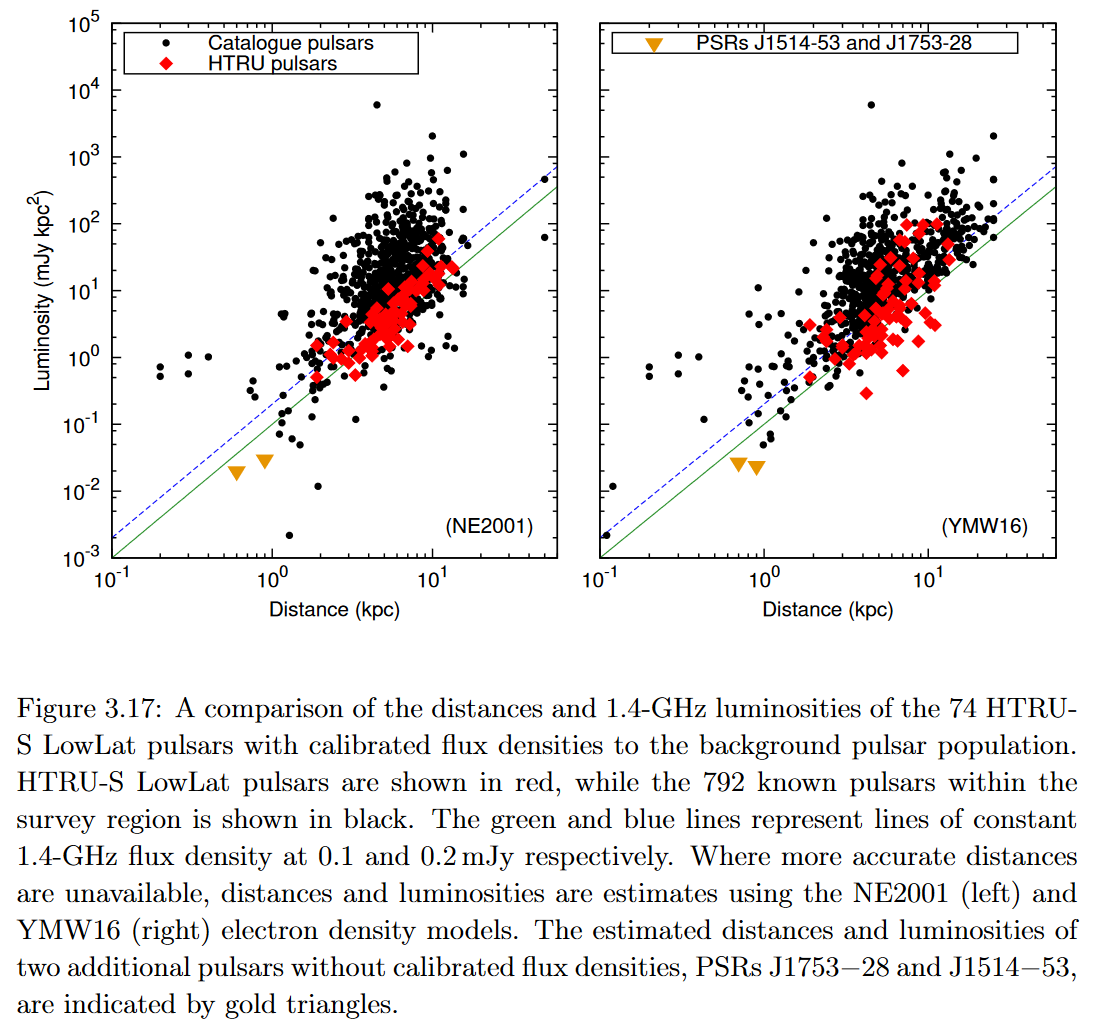
20240820
1. PhD, Martinez_2019_Pulsar Searching and Timing with the Arecibo and Effelsberg Radio Telescopes
1--Timing of recycled pulsars has many important applications, such as the study of ultra-dense matter (Özel & Freire, 2016), the tests of relativistic theories of gravity (Kramer et al., 2006), the search for low-frequency gravitational waves (Verbiest et al., 2016), and evolution of binary systems (Bhattacharya & van den Heuvel, 1991; Tauris et al., 2011, 2012).
2--Isolated radio pulsars masses cannot be measured, since all of the current methods rely on precise tracking of the orbital motions through pulsar timing of binary pulsars. It is important to probe the distribution of neutron star masses in order to understand the nature of supernovae and neutron star formations, as well as binary stellar evolution and their interactions.
3--PSR J0154+1833 is an isolated MSP with a spin period of 2.36 ms and a DM of 19.79 pc cm^{−1}. The evolution scenario for isolated millisecond pulsars is a mystery. There are two hypothesis that may explain their evolution. One is that some MSPs are evaporating their companion, a hypothesis coming from the first eclipsing pulsar binary system, which are now known as black-widow system (Fruchter et al., 1988). These black-widow systems have an eclipsing orbital periods (∼ few hours) and very low mass companions (~0.1M). The companion is undergoing mass loss from being ablated by the strong wind of the pulsar. This was believed that the strong ablation process seen in PSR B1957+20 and similar objects could eventually make the companion star completely evaporate, thus providing an explanation for the existence of isolated MSPs in the Galaxy (Fruchter et al., 1988). However, it was later realized that the typical timescale for such a process would be too long (more than a Hubble time) to complete and thus the idea was abandoned (Ryba & Taylor, 1991). Another hypothesis is that some isolated MSPs are ejected from globular clusters (GCs). Many exchange encounters happen inside GCs, where some isolated MSPs are located within or just outside GC, some could even be kicked out fully from GCs gravitational wells. Nevertheless, up to this date, no hypothesis fully describes how the total population of isolated MSPs in our galaxy are formed.
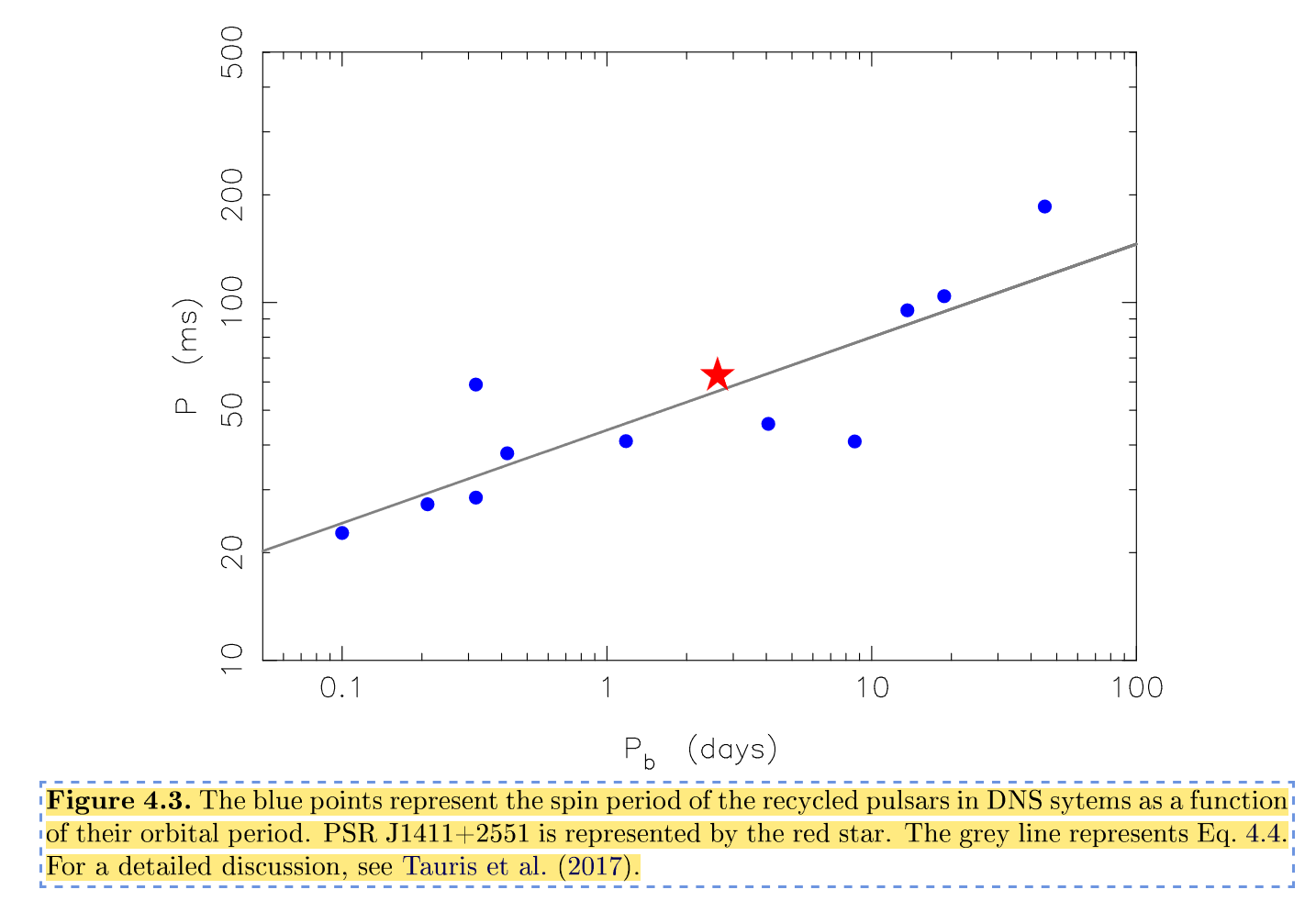

2. PhD, Lazarus_2016_Pulsar Discoveries and their Exploitation
The Many Applications of Pulsars:
1--Measuring Neutron Star Masses; Type of pulsar : Binary (MSP or mildly recycled); Type of analysis: Timing
2--Studying Ultra-Dense Matter; Type of pulsar : Binary (MSP or mildly recycled); Type of analysis: Timing
3--Testing Relativistic Gravity; Type of pulsar : Binary (MSP or mildly recycled), isolated MSPs; Type of analysis: Timing, profile stability
4--Probing the Interstellar Medium; Type of pulsar : All; Type of analysis: Wide bandwidth or multi-frequency observations
5--Building a Gravitational Wave Detector; Type of pulsar : MSPs (extremely stable rotators); Type of analysis: Timing
6--Investigating Binary Stellar Evolution; Type of pulsar : Binary (MSP or mildly recycled); Type of analysis: Timing, modelling
7--Modelling the Underlying Pulsar Population; Type of pulsar : All; Type of analysis: Pulsar surveys (i.e. discoveries), modelling
Most known pulsars were discovered from their radio emission. Searches for radio pulsars generally fall into one of two categories: blind searches and targeted searches. \(Blind~searches\) are the basis of large-scale pulsar surveys, which search a wide patch of the sky for radio pulsars, and are responsible for many scientifically interesting pulsars.
\(Targeted~searches\), on the other hand, consist of searching for pulsar signals in observations of specific sky positions thought to likely contain radio pulsars. These might include globular clusters (GCs; e.g. Lyne et al., 1988; Manchester et al., 1991; Ransom et al., 2005), supernova remnants (e.g. Manchester, 1988; Kaspi et al., 1996; Lorimer et al., 1998), the positions of gamma-ray point sources (e.g Ransom et al., 2011; Cognard et al., 2011; Keith et al., 2011; Barr et al., 2013a), or the positions of NSs found in other bands (e.g. Kondratiev et al., 2009; Lazarus et al., 2012).
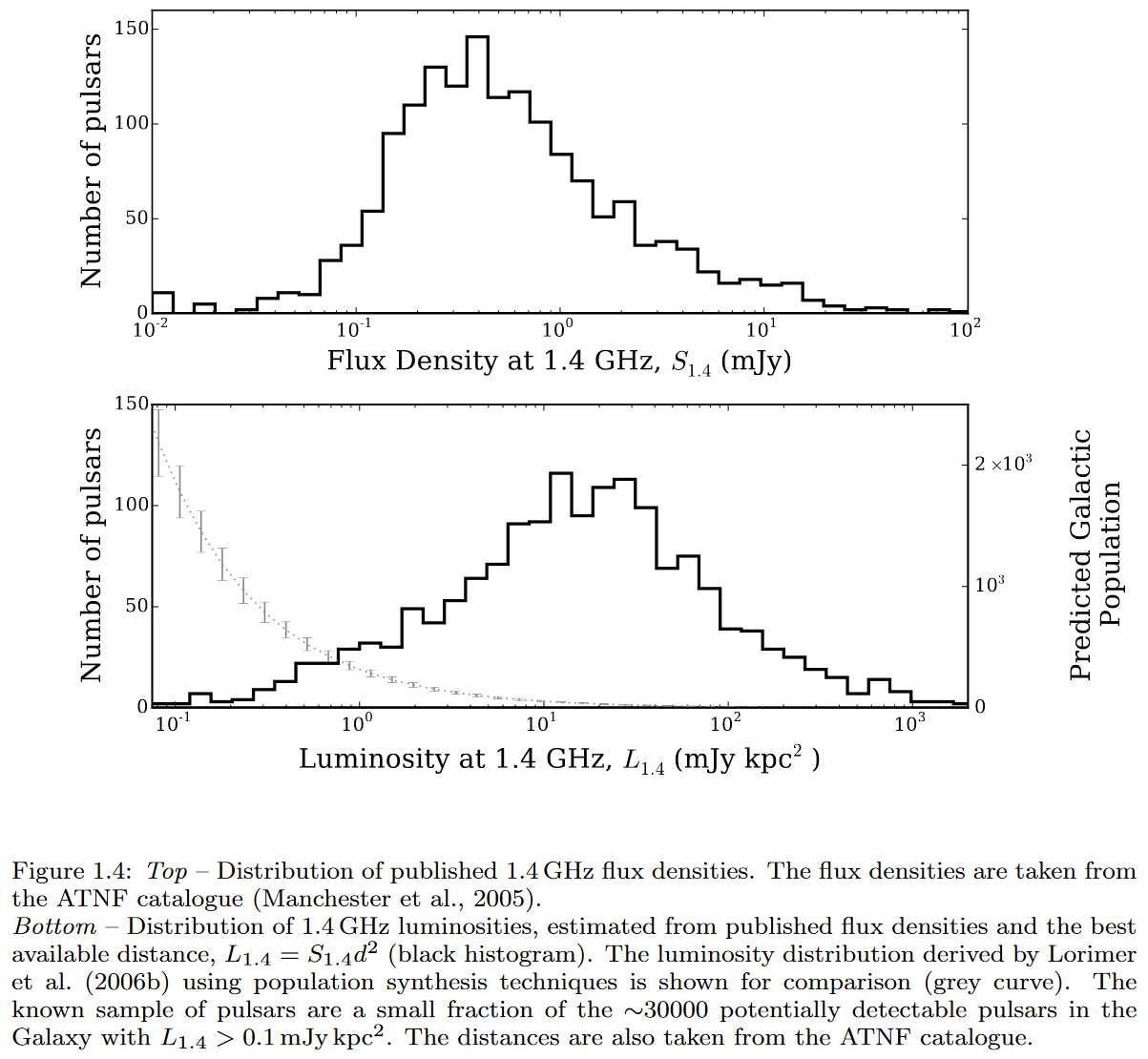


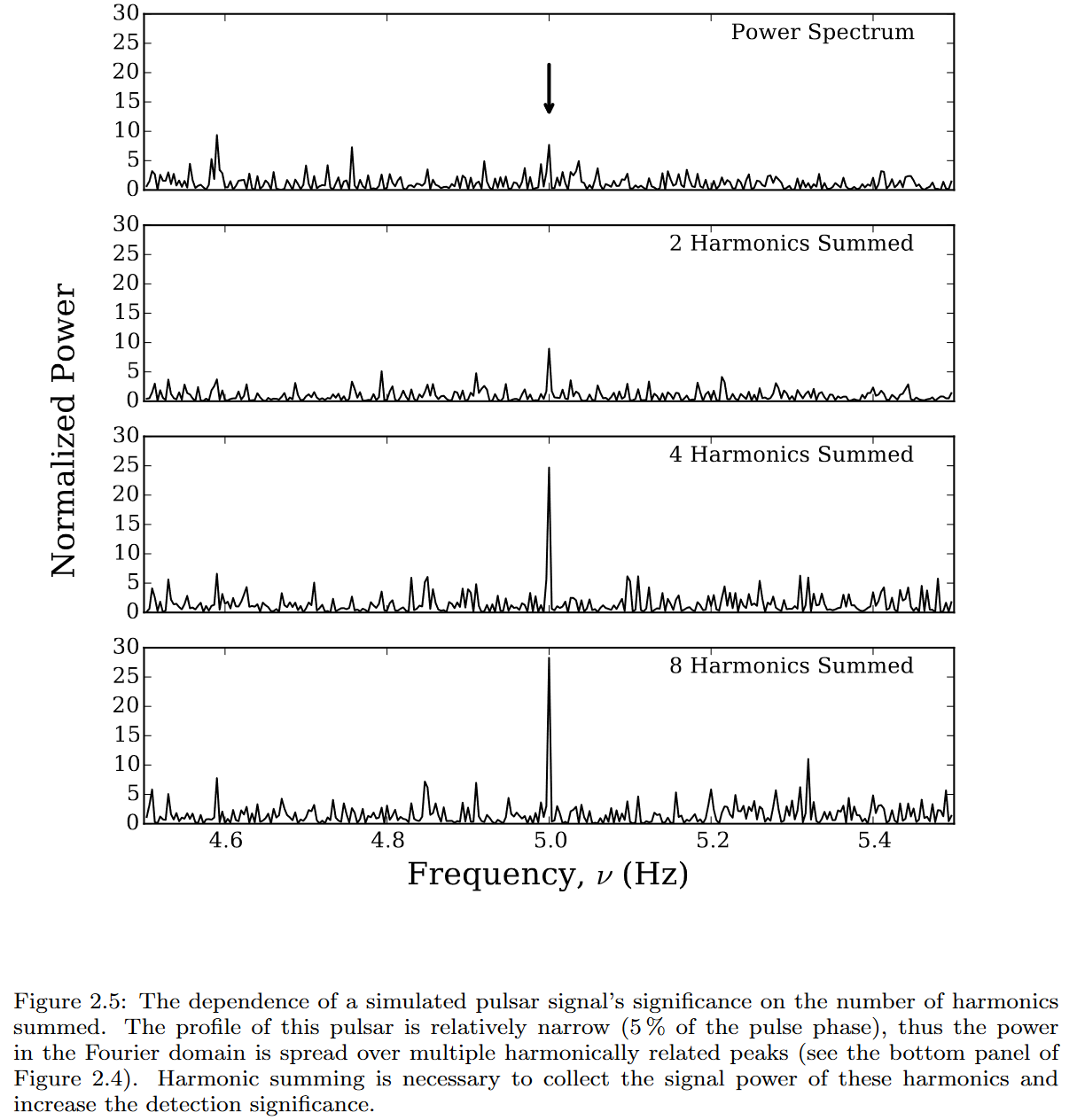
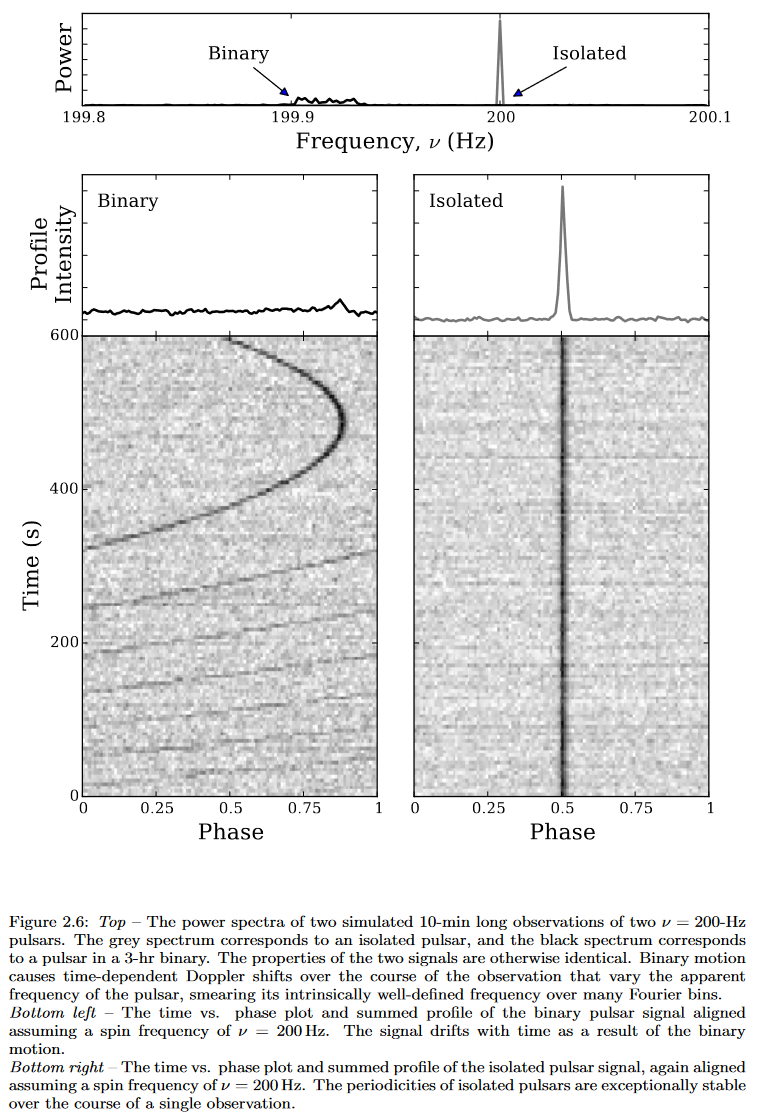
3. PhD, Tasha GAUTAM_2022_Millisecond pulsars in the era of sensitive telescopes
Pulsars in GCs also help understand the cluster dynamics itself. The gravitational potential of the cluster exerts an additional acceleration on pulsars that can be observed in the spin period and orbital period derivatives of these systems. By estimating these contributions on multiple pulsars located at various distances from the cluster core, one can predict the cluster potential model (Phinney, 1993; Freire et al., 2017a; Prager et al., 2017). Additionally, by estimating the DM and position of the pulsars, we can get an insight into the distribution of the ionised intra-cluster medium (Freire et al., 2001). Furthermore, a comprehensive study of RMs of pulsars in a cluster can provide a better understanding of the cluster’s magnetic field distribution (Abbate et al., 2018).
20240817
1. Thesis, Balakrishnan_2022_Novel Search Techniques to Detect Pulsar Black Hole Binaries in Radio
1--The template-bank algorithm is used to search for pulsars systems in a compact orbits, especial for Pulsar - Stellar Mass Black Hole (PSR-BH) binaries! This new method brings an extra sensitivity factor of 2-2.5 compared to previous searches.
2--A novel Machine-learning pulsar candidate classifier using Semi-Supervised Generative Adversarial Networks is utilized to achieved the candidates sifting.
20240816
1. Thesis, Wongphechauxsorn_2024_Searching for pulsars in the Galactic centre and timing of a massive pulsar
The "AFFA"--acceleration Fast Fold Algorithm pipeline was applied to different datasets, including a white dwarf (WD) pulsar candidate, a core-collapsed globular cluster (M15), and a non core-collapsed globular cluster (47 Tuc). In the future, the "jerk" will be considered in the FFA pipeline. These pipelines is more sensitive to long-period pulsars than FFT, since there no harmonic summing limits problem.
2. The High Time Resolution Universe Pulsar survey - XVIII. The reprocessing of the HTRU-S Low Lat survey around the Galactic Centre using a Fast Folding Algorithm pipeline for accelerated pulsars
https://ui.adsabs.harvard.edu/abs/2024MNRAS.527.3208W/abstract
The HTRU-S Low Latitude survey data within 1° of the Galactic Centre (GC) were searched for pulsars using the Fast Folding Algorithm (FFA). Unlike traditional Fast Fourier Transform (FFT) pipelines, the FFA optimally folds the data for all possible periods over a given range, which is particularly advantageous for pulsars with low-duty cycles. For the first time, a search over acceleration was included in the FFA to improve its sensitivity to binary pulsars.
3. Multi-epoch searches for relativistic binary pulsars and fast transients in the Galactic Centre
https://ui.adsabs.harvard.edu/abs/2021MNRAS.507.5053E/abstract
Here, we present multi-epoch pulsar searches of the Galactic Centre at four observing frequencies, 4.85,8.35,14.6,18.95GHz, using the Effelsberg 100-m radio telescope. Our data analysis features acceleration searches on progressively shorter time series to maintain sensitivity to relativistic binary pulsars. The multi-epoch observations increase the likelihood of discovering transient or nulling pulsars, or ensure orbital phases are observed at which acceleration search methods work optimally. In ∼147h of separate observations, no previously undiscovered pulsars have been detected.
4. The role of FAST in pulsar timing arrays
https://ui.adsabs.harvard.edu/abs/2019RAA....19...20H/abstract
The primary goals for PTAs are to detect (and subsequently study) ultra-low-frequency gravitational waves, to develop a pulsar-based time standard and to improve solar system planetary ephemerides. We describe how FAST will contribute to PTA research and show that jitter- and timing-noise will be the limiting noise processes for FAST data sets. Jitter noise will limit the timing precision achievable over data spans of a few years while timing noise will limit the precision achievable over many years.
2023-7-30
1,Optimal periodicity searching: revisiting the fast folding algorithm for large-scale pulsar surveys
https://ui.adsabs.harvard.edu/abs/2020MNRAS.497.4654M/abstract
The fast folding algorithm (FFA) is a phase-coherent search technique for periodic signals. It has rarely been used in radio pulsar searches, have been historically supplanted by the computationally expensive fast fourier transform (FFA) with harmonic summing. A portion of the pulse phase space has thus been systematically underexplored for decades; pulsar surveys aiming to fully sample the pulsar population should include an FFA search as part of their data analysis. A FFA pulsar search package, RIPTIDE, was developed for process radio observation on a large scale.
In Kondratiev et al. 2009, its conclusion was that the FFA is better at detecting pulsars with both long periods (P >= 2 s) and short duty cycles (\(\delta\) <= 1 per cent). In Lazarus et al. 2015, a through analysis of the sensitivity of the PALFA pulsar survey revealed that FFT searches do not reach their expected theoretical sensitivity to P >= 100 ms pulsars on real-world data, an effect that worsens for longer periods of a few seconds or more. Parent et al. 2018 did a similar analysis on artificial data, and reported that on real PALFA survey data, their FFA implementation was on average more sensitive to pulsars with periods longer than a second than the FFT-based PRESTO pipeline.
In this paper, the FFA search procedure is demonstrated more sensitive than its FFT counterpart to all periodic signals.
The efficacy of the FFA in a real search.
Keane et al. (2018), the SUPERB survey.
The 23.5-s PSR J0250+5854 in Tan et al. (2018)
The timing solutions for these discoveries in Spiewak et al. (2020)
The SUrvey for pulsars and extragalactic radio bursts V: recent discoveries and full timing solutions
https://ui.adsabs.harvard.edu/abs/2020MNRAS.496.4836S/abstract
2023-7-13
1,A High-frequency Search for Pulsars within the Central Parsec of Sgr A*
https://ui.adsabs.harvard.edu/abs/2010ApJ...715..939M/abstract
The highest frequency of 14.8 GHz pulsars searching for the Galactic center to date was conducted with GBT within the central parsec of Sgr A\(^*\), and no convincing candidate was detected with a 10-sigma detection threshold. About 90 normal pulsars were estimated for an upper limit around Sgr A\(^*\).
The telescope was not pointing at the GC in some time. While attempts were made to group these sessions as close together as possible (so as to combine multiple sessions in a search), this was often not possible due to poor high-frequency observing weather. The Spatial Modulation Search or observation for radio pulsar.
2023-7-12
1,Bursts from Space: MeerKAT – the first citizen science project dedicated to commensal radio transients
https://ui.adsabs.harvard.edu/abs/2023MNRAS.523.2219A/abstract
Their volunteers discovered 142 new variable, including a known pulsar counterparts and an OH Maser star, also the known stellar flares and X-rays binary jets was discovered. a full catalogue of candidate radio variables was presented. The machine learning techniques is developing to class transients.
Searching for radio transients bearing fruit, but is not optimal. The volume of data to analyze is far greater than any one person can achieve by eye on reasonable time-scales.
The Python package of astroquery is used to crossmatch data base, such as SIMBAD and several catalogues within Vizier. These sources span a broad range of physics phenomenon including pulsars, radio-loud stars, XRBs, and a large set of AGN - likely varying due to scintillation.
2, MeerKAT caught a Mini Mouse: serendipitous detection of a young radio pulsar escaping its birth site
https://ui.adsabs.harvard.edu/abs/2023MNRAS.523.2850M/abstract
MeerKAT discovered a radio nebula with cometary-like morphology called "the Mini Mouse", from the previously unidentified candidate supernova G45.24+0.18, which hosts a 138 ms radio pulsar PSR J1914+1054g from FAST GPPS survey. The timing solution of pulsar is obtained with a span of 90 days observations. The derived characteristic age is 83 Kyr.
A bow shock is formed while a pulsar moves through the interstellar medium (ISM) at a supersonic speed and pulsar wind in the direction opposite to that odd the pulsar's motion.
One observation lasted 90 minutes, of which 60 min was on-source, 20 min on the primary calibrator and 3 min on the second calibrator. MeerKAT will help unveiling more young radio pulsars which will add to the still small population of such objects.
3,Rotation measure variations in Galactic Centre pulsars
https://ui.adsabs.harvard.edu/abs/2023arXiv230703230A/abstract
Four pulsars in the Central Molecular Zone (CMZ) is observed using 100-m Effelsberg. PSR J1746 shows significant variations of rotation measure (RM) of 300-400 rad m^{-2} that suggest a strongly magnetized environment, this pulsar also shows large dispersion measure (DM) variation of ~50 pc cm^{-3} in an event lasting a few months where the RM increased by ~ 200 rad m^{-2}.
These results bring us to understand the magnetic field in the CMZ and show similarities between the RM behaviours of these pulsars and some fast radio bursts (FRB).
The ISM surrounding the supermassive black hole Sagittarius A* (Sgr A) at the center of the Milky way is quite extreme when compared to the Galactic disk. The CMZ region is surrounding Sgr A with a radius of ~150 pc.
One way that can be utilized to obtain the magnetic field is through the RM and DM of pulsars located within this region.
4, A new redback pulsar candidate 4FGL J2054.2+6904
https://arxiv.org/pdf/2306.17593.pdf
A total of ~2000 unassociated gamma-ray sources is contained in the Fermi catalogue. Some of these sources were identified as pulsars, including redbacks and black widows. The Lomb-Scargle method is utilized to search for periodic brightness variation in the range of 1-24 h.
5, Observations of Asynchronous Orbital Frequencies of the Redback Millisecond Pulsar PSR J1723-2837
A total of eight years observation data for PSR J1723-2837 is carried by Kepler K2 photometry. This system is not synchronized to the orbital period from the modulated light curve signals.
6, A supernova remnant association for the fast-moving pulsar PSR J0908–4913
https://arxiv.org/pdf/2108.09827.pdf
The proper motion of PSR J0908-4913 shows that it is a fast moving object, which is suggested to be located at the edge of a previously unknown, filled-center supernova remnant, G270.4-1.0.
Finally, we note that Yao et al. (2021) have recently determined a full three dimensional picture of the motion of PSR J0538+2817 within its SNR via a combination of radio polarization and scintillation measurements. Such an approach should also be possible for PSR J0908-4913 through sensitive observations using MeerKAT.
7,Study of 72 Pulsars Discovered in the PALFA Survey: Timing Analysis, Glitch Activity, Emission Variability, and a Pulsar in an E
https://inspirehep.net/files/55572b747e56dd023d274574d1bb4606
A total of 72 new discoveries and their long-term timing solutions from the Pulsar Arecibo L-band Feed Array (PALFA) survey was presented.
The wealth of astrophysical studies emerging from pulsar astronomy is often made possible by long-term monitoring and timing of newly discovered sources. Pulsar timing builds upon their remarkable rotational stability and consists of developing a mathematical model that accurately and precisely predicts the time of a pulse emitted by a pulsar when detected on Earth. This leads directly to high-precision measurements of spin, astrometric, dispersion and possible binary parameters.
A total of 207 pulsars were discovered, 46 of which ware MSPs.
The timing analysis is performed with PRESTO (prepfold and get_TOAs.py) and TEMPO (JPL DE436 planetary ephemeris and UTC(NIST) time standard). The timing analysis was carried out with the TEMPO software package, which implements a χ2 minimization technique to compute the best-fit parameters of a timing model.
2023-7-11
1, A new pulsar candidate in 47 Tucanae discovered with MeerKAT imaging
https://arxiv.org/pdf/2307.02077.pdf
The ASKAP (Hotan et al. 2021) and MeerKAT (Jonas & MeerKAT Team 2016) use image-domain data to discover new pulsars, and to expand the parameter space for the discovery of variables and transienst. Using image domain and spectral domain, finding a new pulsar candidate or known pulsar with unknown or unaccurate timing solution. These method is utilized to detect potential pulsars that are beyond the death lines in P-Pdot parameter space.
2 , The GMRT High Resolution Southern Sky Survey for pulsars and transients – VI: Discovery of nulling, localisation and timing of PSR J1244−4708
https://arxiv.org/pdf/2307.01477.pdf
A nulling pulsar was discovered from GHRSS of GMRT and an new searching pipeline aimed extreme nulling pulsars was presented based Fast Folding Algorithm (FFA) and Fast Fourier Transform.
The average profile of pulsars is used to study their average beam shape and geometry, while the single pulse properties such as microstructures, subpulse drifting, mode changing, nulling and intermittency are utilized to analysis their exact physics of radio emission.
FFT method require a signal of consistent periodicity, FFA is to fold the time series by trial periods and signal can be captured in the folded profile. The most sensitive method for searching for non-accelerated periodic signals is FFA.
3,K2 & TESS observations of symbiotic X-ray binaries: GX 1+4 and IGR J16194-2810
https://arxiv.org/pdf/2307.01873.pdf
Symbiotic binaries consists of compact object accreting from a red giant companion. These symbiotics with neutron stars are known as symbiotic X-ray binaries, about a dozen of these systems are discovered. These paper use Kepler and TESS archival observations to analysis symbiotic binaries.



